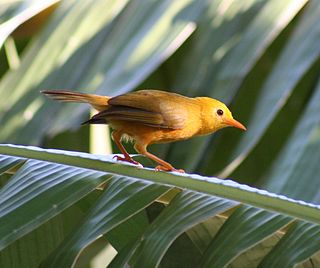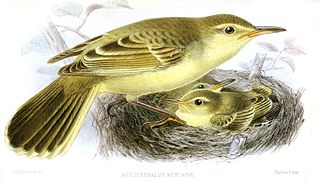
The Acrocephalus warblers are small, insectivorous passerine birds belonging to the genus Acrocephalus. Formerly in the paraphyletic Old World warbler assemblage, they are now separated as the namesake of the marsh and tree warbler family Acrocephalidae. They are sometimes called marsh warblers or reed warblers, but this invites confusion with marsh warbler and reed warbler.
The Eiao Marquesan warbler is a subspecies of the northern Marquesan reed warbler found only in the dry upland forest on Eiao in the northern Marquesas Islands.

The Australian reed warbler is an Old World warbler in the genus Acrocephalus and is the only Acrocephalus species native to Australia. It has also been observed in Papua New Guinea and nearby islands. The name Acrocephalus refers to the peaked crown found on reed warblers in this genus and can be translated to mean "topmost head" in Greek. The species name australis is translated to mean "southern" in Latin, and refers to the species range, Australia. In its western range the Australian reed warbler is also known as "Koordjikotji" in the local Aboriginal language of Perth and its surrounds.

The nightingale reed warbler, or Guam reed-warbler, is an extinct songbird that was endemic to Guam.

The large-billed reed warbler is an Old World warbler in the genus Acrocephalus. The species has been dubbed as "the world's least known bird". It was known from a single specimen collected in India in 1867 and rediscovered in the wild in Thailand in 2006. The identity of the bird caught in Thailand was established by matching DNA sequences extracted from feathers; the bird was released. After the rediscovery in the wild a second specimen was discovered amid Acrocephalus dumetorum specimens in the collections of the Natural History Museum at Tring. A breeding area was found in Afghanistan in 2009 and studies in 2011 pointed to its breeding in Kazakhstan and Tajikistan. One bird was found in the Baikka Wetland in Srimangal, Bangladesh on 7 December 2011.

The Acrocephalidae are a family of oscine passerine birds, in the superfamily Sylvioidea.

The Cook reed warbler or Cook Islands reed warbler, is a species of Old World warbler in the family Acrocephalidae. It is native to the southeastern Cook Islands. Its natural habitats are subtropical or tropical dry forests, swamps, and rural gardens. It is threatened by habitat loss.

The Caroline reed warbler or Caroline Islands reed warbler is a species of Old World warbler in the family Acrocephalidae. It is found only on the Caroline Islands in Micronesia.

The golden white-eye is a species of bird in the white-eye family, Zosteropidae. It is the only species within the genus Cleptornis. The golden white-eye was once considered to be a honeyeater in the family Meliphagidae and although it is now known to be a white-eye, its position within that family is still uncertain. The species is restricted to the islands of Saipan and Aguijan in the Northern Mariana Islands, where it is sympatric and competes with the related bridled white-eye. The golden white-eye has golden plumage and a pale eye-ring. It feeds on insects, fruit, and nectar and forages in pairs or small family groups. The bird is monogamous and lays two eggs in a small cup nest.

The southern Marquesan reed warbler is a species of Old World warbler in the family Acrocephalidae.

The Saipan reed warbler or gå'ga' karisu in Chamorro is a critically endangered songbird of the Northern Mariana Islands.

The northern Marquesan reed warbler is a species of Old World warbler in the family Acrocephalidae. It was formerly considered conspecific with the southern Marquesan reed warbler, and together known as the Marquesan reed warbler. It is found on the northern Marquesas Islands.

Moorea reed warbler is a species of songbird in the genus Acrocephalus. Formerly placed in the "Old World warbler" assemblage (Sylviidae), it is now in the newly recognized marsh warbler family Acrocephalidae. It was once considered a subspecies of the Tahiti reed warbler.

The Nauru reed warbler is a passerine bird endemic to the island of Nauru in the Pacific Ocean. It is one of only two native breeding land-birds on Nauru and it is the only passerine found on the island. It is related to other Micronesian reed warblers, all of which evolved from one of several radiations of the genus across the Pacific. Related warblers on nearby islands include the Caroline reed warbler, with which the Nauru species was initially confused, and the nightingale reed warbler, which was formerly sometimes considered the same species.

The Tuamotu tropical moist forests is a tropical and subtropical moist broadleaf forests ecoregion in the Tuamotu Archipelago of French Polynesia and the Pitcairn Islands.
The mangarevan whistler is a dubious species of extinct bird in the family Pachycephalidae that was once found in Mangareva in French Polynesia.













